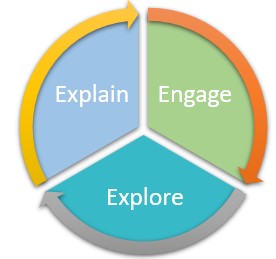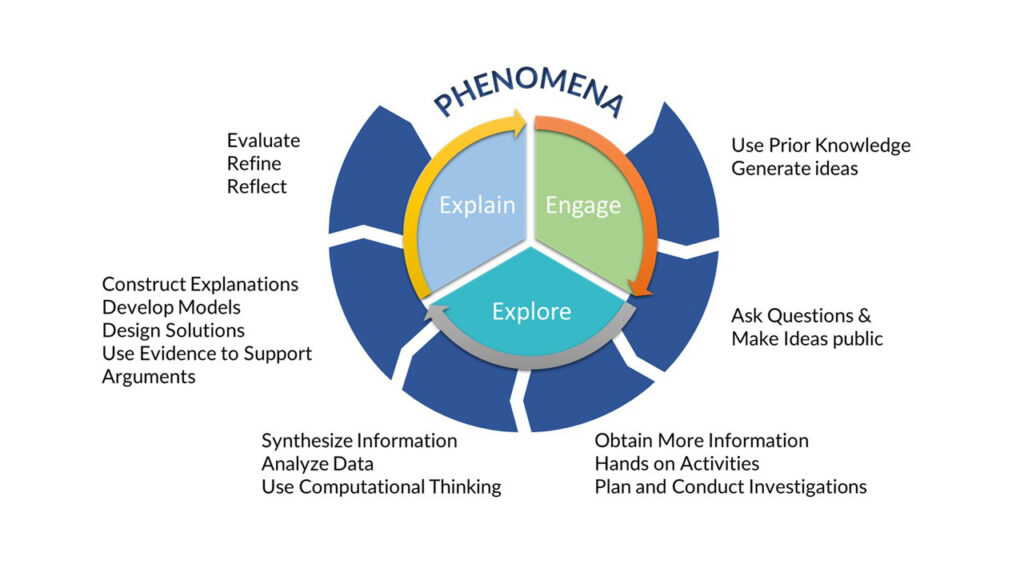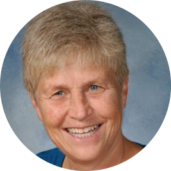Get support for student success - right in your inbox
NHLI | New Hampshire Learning Initiative
All Students Deserve a Quality Education
/ March 19, 2024
Unlocking Curiosity: A Paradigm Shift in Science Education
Integrating Phenomena to Foster Sensemaking Skills in Students
“When students as scientists have authentic, relevant opportunities to actively make sense of the world and beyond – what we call sensemaking – science learning becomes engaging, accessible, and important to ALL students.” Sensemaking | NSTA.
A shift in teacher thinking is required to create sensemaking opportunities in the classroom. This paradigm shift and anchoring lessons in phenomena help foster curiosity. This blog will discuss the paradigm shift and how to integrate it with phenomena to develop our students’ sensemaking skills.
Paradigm Shift
We begin with a paradigm shift in how education is delivered. In the paradigm shift, teachers allow students to “Engage, Explore & then Explain.” Traditionally, science education begins with an explanation, starting with an introduction to the unit that often contains new vocabulary and an explanation of the science to be studied. This information is then used in an experiment or hands-on activity so students can “prove” the explanation. The assessment for the unit is then a check to see if the student can repeat what they have previously learned. Students parrot back to the teacher the information they received from the teacher. In the constructivist model, students engage in sensemaking, calling on their prior knowledge; they explore possibilities regarding the phenomena and finally explain their reasoning. A science teacher, Heather Wheeler, shares that “scientists engage in sensemaking in the real world; they ask questions and investigate to find answers. Sometimes, those answers are what the scientist expects to find, and sometimes not. That’s authentic science. When students investigate to find answers and make sense of what those answers tell them, This allows them to be scientists!”

Engage thru Phenomena
Students begin by engaging in phenomena, authentic problems, or issues with authentic context. Phenomena is an observable event in the natural world. For example, a flock of Canadian geese landed on the front lawn of a school in NH in the fall. Scientists know how this phenomenon works, but students do not understand it. The idea here is to pique students’ curiosity, so they become interested in understanding what they observe. The teacher asks if any students have questions about what they have seen. Some students want to discuss what they know, and others are full of questions. Using phenomena allows students to activate their prior knowledge and realize where their knowledge is insufficient, leading students into the exploration phase.
Explore using the Science and Engineering Practices and Cross Cutting Concepts
The teacher needs to harness this curiosity and use it to explore the many facets of migration. To begin with, the teacher asks all the students to write down their questions on sticky notes. The students then organize the sticky notes into similar questions and devise a list of questions they want to explore. Many students wanted to know, “How do Canadian geese understand when it is time to fly south for the winter? A light source and globe will allow students to “see” how sunlight and the length of day change in the fall and compare it to other seasons. Students will be encouraged to ask testable questions, discuss explanations, design experiments, and seek additional information. The teacher is not explaining the reasons for the changing seasons but is allowing students to explore how they could change the length of day or the amount of sunlight, putting the students at the center of their learning and helping them fill in the gaps in their understanding.
Explain using Scientific Language
The final phase of this paradigm shift is to make sense of the new information, synthesize it with the prior knowledge, and be able to “Explain” how the parts fit together to provide a more complete understanding of the original phenomena. In this phase, students are encouraged to use the language of science. Not only should the scientific vocabulary be used, but the explanation/model should incorporate the ideas scientists use (i.e., the cross-cutting concepts.) In so doing, the students construct and own their knowledge and understanding and move towards applying that knowledge.
Roadmap
The next generation science standards, NGSS, provide and support this paradigm shift. Figure 2 shows that instruction begins and ends with phenomena. In addition to the Disciplinary Core Ideas(DCI), NGSS emphasizes the integration of the Science and Engineering Practices(SEP) and the Cross-Cutting Concepts(CCC) into the making sense of phenomena. This figure illustrates how the paradigm shift can help map out the flow of knowledge construction. This road map for understanding translates the change in delivering information into actionable activities in the classroom.

The key to this paradigm shift is the use of phenomena. Explanations of Phenomena can range from very simple to highly complex. Anchoring phenomena represents complex ideas that might only be understandable by developing a foundational understanding. Canadian Geese migration is an anchoring phenomenon. Presenting students with complex anchoring phenomena may require several iterations of this road map to construct the knowledge necessary to explain the anchoring phenomena fully. Here, the teacher helps students construct their knowledge through activities. In our Canadian geese example, the teacher might use simple daily phenomena to construct knowledge around seasons, seasonal daily sunlight, the night sky, seasonal temperature changes, and food availability. Each of these phenomena adds to the student’s understanding as they build towards a more complete explanation of the anchoring phenomena.
Summary
The skill of sensemaking not only creates a better understanding of the phenomena. It also gives students the agency to construct their knowledge. The paradigm shift in the delivery of instruction with the use of daily and anchoring phenomena allows our students to make sense of the world around them.
Categories: NHLInsights, Research and Resources
